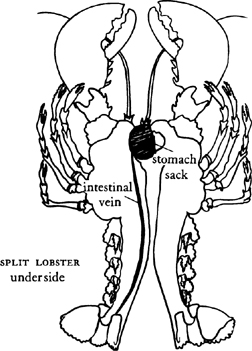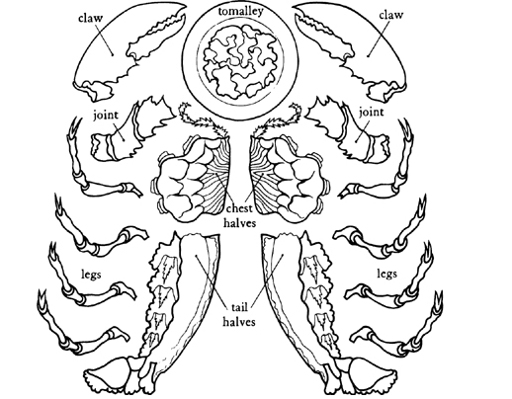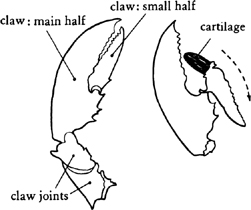Mastering the Art of French Cooking, Volume 2 (14 page)
Read Mastering the Art of French Cooking, Volume 2 Online
Authors: Julia Child

To tell the sex of a lobster, look at the last pair of swimmerets on the underside, where chest meets tail. If they are soft and hairy, the lobster is female; if they are hard, pointed, and hairless, the lobster is male. |
|
ON DEALING WITH LIVE LOBSTERS
A number of the best French lobster recipes, including
homard à l’américaine
and
bisque de homard
, call for the sautéing of cut-up raw lobster. This means you must buy live lobster and either have it cut up for you and cook it immediately, or do the cutting yourself. The serious cook really must face up to the task personally. While professionals simply cut up the lobsters with never a qualm nor a preliminary, you may find this difficult. If so, we suggest that you plunge them two at a time, head first and upside down, into boiling water; leave for about a minute, until lobsters are limp, and immediately remove them. Because the nervous and circulatory systems of the lobster center in the head area, a head-first plunge into boiling liquid not only kills the lobster almost instantly, but also eliminates muscle spasms. There is a misguided notion that lobsters suffer less if set to boil in cold water; far from being a humane procedure, this is slow death by drowning!
HOW TO CUT UP RAW LOBSTER
Furnish yourself with sharp-pointed lobster scissors or kitchen scissors, a large knife, a cutting board with groove to catch juices or a board set on a tray, a bowl to pour juices into, and another bowl for the lobster tomalley. You now want to split the lobster in two, lengthwise, as follows. Turn the lobster top side up. With scissors, cut through center of shell from end of tail up to but not through eyes in center of head. Turn lobster over and again with scissors cut through shell from end of tail to within ½ inch of tip of head. Then with your knife cut completely through the under side of the lobster lengthwise, following scissor cuts, from ½ inch below tip of head down through tail, thus splitting lobster neatly in two except at
the head. Finally grasp
lobster in both hands where claw joints meet chest, and break the shell apart at the head to open it up.
| Nestled in the head on one side of the lobster or the other is a pouch an inch long and ¾ inch in diameter which is the stomach sack. Locate the sack with your fingers, twist it out, and discard it. (If you have cut sack in two while splitting the lobster, no harm is done; remove the 2 halves.) Pull out and discard the intestinal vein, a thin, flexible translucent or blackish tube that runs from the area of the stomach sack down through the tail meat. The greenish, and sometimes almost blackish, soft matter lying in the chest cavity is the tomalley; scoop it out into a small bowl. If your lobster is female, there will usually be some orange-red roe as well; add this to the tomalley. |
With a knife or scissors, separate the two tail sections from the chests. Cut the legs and the claw joints from the chests, and cut claws from end of joints. Crack claws in one or two places with a sharp whack of the knife. Drain juices into a bowl and reserve them, along with the tomalley. The lobster is now ready for sautéing.
HOW TO REMOVE THE MEAT FROM COOKED LOBSTERS
Split and open boiled lobster exactly as described in the preceding directions for raw lobster. Discard stomach sack and intestinal vein. Scoop tomalley from inside the chest sections into a bowl. After lifting meat out of tail sections, you want to remove meat from claws, claw joints, chest sections, and legs. With scissors, cut the claw joints from the chests, and separate each claw from its joint. Cut through shell on each side of joints, lift off shell, and remove meat.
| The first step in removing the meat from the claws is to |





